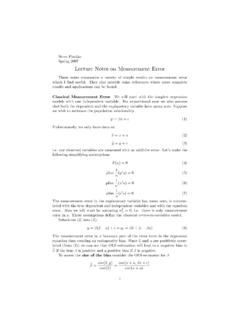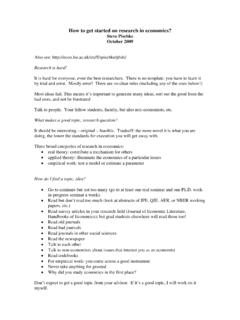Transcription of The Basic Theory of Human Capital - Department of …
1 chapter 1 The Basic Theory of Human Capital1. General IssuesOne of the most important ideas in labor economics is to think of the set ofmarketable skills of workers as a form of Capital in which workers make a varietyof investments. This perspective is important in understanding both investmentincentives, and the structure of wages and speaking, Human Capital corresponds to any stock of knowledge or char-acteristics the worker has (either innate or acquired) that contributes to his or her productivity . This definition is broad, and this has both advantages and disad-vantages. The advantages are clear: it enables us to think of not only the yearsof schooling, but also of a variety of other characteristics as part of Human capitalinvestments. These include school quality, training, attitudes towards work, etc. Us-ing this type of reasoning, we can make some progress towards understanding someof the differences in earnings across workers that are not accounted by schoolingdifferences disadvantages are also related.
2 At some level, we can push this notion ofhuman Capital too far, and think of every difference in remuneration that we observein the labor market as due to Human Capital . For example, if I am paid less thananother , that must be because I have lower skills in some other dimensionthat s not being measured by my years of schooling this is the famous (or infamous)unobserved heterogeneityissue. The presumption that all pay differences are relatedto skills (even if these skills are unobserved to the economists in the standard datasets) is not a bad place to start when we want to impose a conceptual structure on3 Lectures in Labor Economicsempirical wage distributions, but there are many notable exceptions, some of whichwill be discussed later. Here it is useful to mention three:(1) Compensating differentials: a worker may be paid less in money, becausehe is receiving part of his compensation in terms of other (hard-to-observe)characteristics of the job, which may include lower effort requirements, morepleasant working conditions, better amenities etc.
3 (2) Labor market imperfections: two workers with the same Human Capital maybe paid different wages because jobs differ in terms of their productivity andpay, and one of them ended up matching with the high productivity job,while the other has matched with the low productivity one.(3) Taste-based discrimination: employers may pay a lower wage to a workerbecause of the worker s gender or race due to their interpreting wage differences, and therefore in thinking of Human Capital in-vestments and the incentives for investment, it is important to strike the right bal-ance between assigning earning differences to unobserved heterogeneity, compensat-ing wage differentials and labor market Uses of Human CapitalThe standard approach in labor economics views Human Capital as a set ofskills/characteristics that increase a worker s productivity. This is a useful start-ing place, and for most practical purposes quite sufficient.
4 Nevertheless, it may beuseful to distinguish between some complementary/alternative ways of thinking ofhuman Capital . Here is a possible classification:(1) The Becker view: Human Capital is directly useful in the production explicitly, Human Capital increases a worker s productivity in all tasks,though possibly differentially in different tasks, organizations, and situa-tions. In this view, although the role of Human Capital in the productionprocess may be quite complex, there is a sense in which we can think of it asrepresented (representable) by a unidimensional object, such as the stock4 Lectures in Labor Economicsof knowledge or skills,h, and this stock is directly part of the productionfunction.(2) The Gardener view: according to this view, we should not think of humancapital as unidimensional, since there are many many dimensions or typesof skills. A simple version of this approach would emphasize mental abilities as different skills.
5 Let us dub this the Gardener view af-ter the work by the social psychologist Howard Gardener, who contributedto the development of multiple-intelligences Theory , in particular emphasiz-ing how many geniuses/famous personalities were very unskilled in someother dimensions.(3) The Schultz/Nelson-Phelps view: Human Capital is viewed mostly as thecapacity to adapt. According to this approach, Human Capital is especiallyuseful in dealing with disequilibrium situations, or more generally, withsituations in which there is a changing environment, and workers have toadapt to this.(4) The Bowles-Gintis view: Human Capital is the capacity to work in or-ganizations, obey orders, in short, adapt to life in a hierarchical/capitalistsociety. According to this view, the main role of schools is to instill inindividuals the correct ideology and approach towards life.(5) The Spence view: observable measures of Human Capital are more a signal ofability than characteristics independently useful in the production their differences, thefirst three views are quite similar, in that humancapital will be valued in the market because it increasesfirms profits.
6 This isstraightforward in the Becker and Schultz views, but also similar in the Gardenerview. In fact, in many applications, labor economists view of Human Capital wouldbe a mixture of these three approaches. Even the Bowles-Gintis view has very similarimplications. Here,firms would pay higher wages to educated workers because theseworkerswillbemoreusefultothefirm as they will obey orders better and will bemore reliable members of thefirm s hierarchy. The Spence view is different from5 Lectures in Labor Economicsthe others, however, in that observable measures of Human Capital may be rewardedbecause they are signals about some other characteristics of workers. We will discussdifferent implications of these views Sources of Human Capital DifferencesIt is useful to think of the possible sources of Human Capital differences beforediscussing the incentives to invest in Human Capital :(1) Innate ability: workers can have different amounts of skills/ Human capitalbecauseofinnatedifferences.
7 Research in biology/social biology has docu-mented that there is some component of IQ which is genetic in origin (thereis a heated debate about the exact importance of this component, and someeconomists have also taken part in this). The relevance of this observationfor labor economics is twofold: (i) there is likely to be heterogeneity inhuman Capital even when individuals have access to the same investmentopportunities and the same economic constraints; (ii) in empirical appli-cations, we have tofind a way of dealing with this source of differencesin Human Capital , especially when it s likely to be correlated with othervariables of interest.(2) Schooling: this has been the focus of much research, since it is the mosteasily observable component of Human Capital investments. It has to beborne in mind, however, that the R2of earnings regressions that control forschooling is relatively small, suggesting that schooling differences accountfor a relatively small fraction of the differences in earnings.
8 Therefore,there is much more to Human Capital than schooling. Nevertheless, theanalysis of schooling is likely to be very informative if we presume thatthesameforcesthataffect schooling investments are also likely to affectnon-schooling investments. So we can infer from the patterns of schoolinginvestments what may be happening to non-schooling investments, whichare more difficult to in Labor Economics(3) School quality and non-schooling investments: a pair of identical twins whogrew up in the same environment until the age of 6, and then completedthe same years of schooling may nevertheless have different amounts ofhuman Capital . This could be because they attended different schools withvarying qualities, but it could also be the case even if they went to the sameschool. In this latter case, for one reason or another, they may have chosento make different investments in other components of their Human Capital (one may have worked harder, or studied especially for some subjects, orbecause of a variety of choices/circumstances, one may have become moreassertive, better at communicating, etc.)
9 Many economists believe thatthese unobserved skills are very important in understanding the structureof wages (and the changes in the structure of wages). The problem is that wedo not have good data on these components of Human Capital . Nevertheless,we will see different ways of inferring what s happening to these dimensionsof Human Capital below.(4) Training: this is the component of Human Capital that workers acquire afterschooling, often associated with some set of skills useful for a particularindustry, or useful with a particular set of technologies. At some level,training is very similar to schooling in that the worker, at least to somedegree, controls how much to invest. But it is also much more complex,since it is difficult for a worker to make training investments by also needs to invest in the training of the workers, and often endsup bearing a large fraction of the costs of these training investments.
10 Therole of thefirmisevengreateroncewetakeintoaccoun tthattraininghasasignificant matching component in the sense that it is most useful fortheworkertoinvestinasetofspecific technologies that thefirm will beusing in the future. So training is often a joint investment byfirms andworkers, complicating the in Labor Economics(5) Pre-labor market influences: there is increasing recognition among econo-miststhatpeergroupeffects to which individuals are exposed before theyjoin the labor market may also affect their Human Capital significantly. Atsome level, the analysis of these pre-labor market influences may be so-ciological . But it also has an element of investment. For example, analtruistic parent deciding where to live is also deciding whether her off-spring will be exposed to good or less good pre-labor market , some of the same issues that arise in thinking about the theoryof schooling and training will apply in this context Human Capital Investments and The Separation TheoremLet us start with the partial equilibrium schooling decisions and establish asimple general result, sometimes referred to as a separation theorem for humancapital investments.






